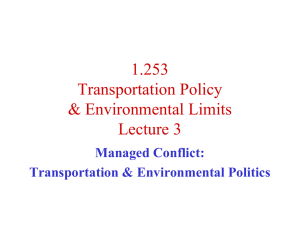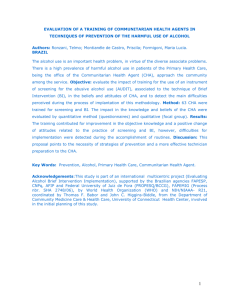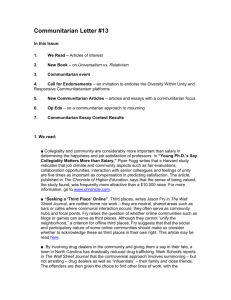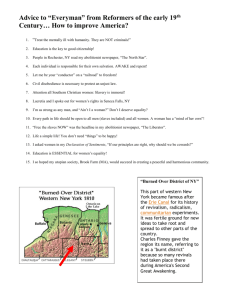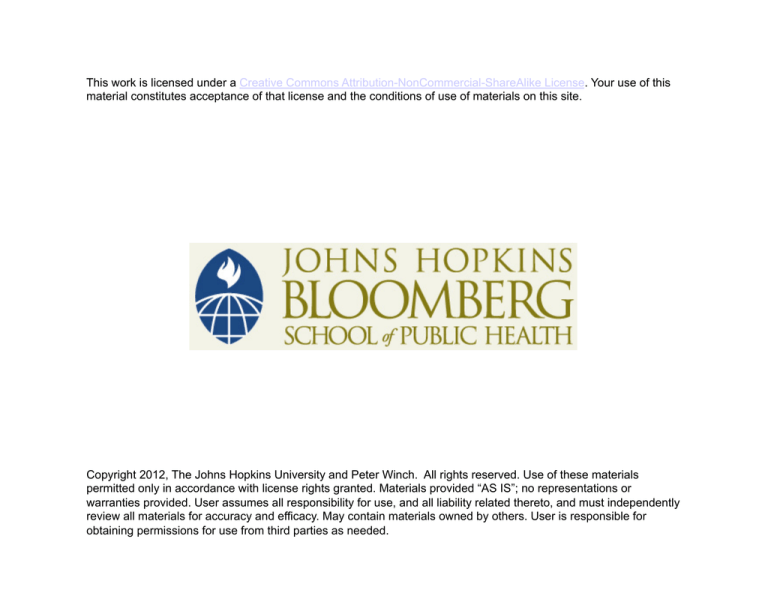
This work is licensed under a Creative Commons Attribution-NonCommercial-ShareAlike License. Your use of this
material constitutes acceptance of that license and the conditions of use of materials on this site.
Copyright 2012, The Johns Hopkins University and Peter Winch. All rights reserved. Use of these materials
permitted only in accordance with license rights granted. Materials provided “AS IS”; no representations or
warranties provided. User assumes all responsibility for use, and all liability related thereto, and must independently
review all materials for accuracy and efficacy. May contain materials owned by others. User is responsible for
obtaining permissions for use from third parties as needed.
Social Capital
Ginny Tedrow
Health Behavior Change at the Individual,
Household and Community Levels
224.689
Types of Capital
Economic
– $$$, property, material wealth
Symbolic
– fame, respect, famous landmarks
Human
– education, ability, personal attributes
Physical
– objects that get the job done (not for
trading)
Social Capital
Key element is cooperative social networks
Social capital is high when people:
– Participate in and contribute to these
networks
– Trust in the good intentions of others in
these networks
– Access information, material and social
support from these networks
– Gain a sense of identity and shared
purpose from participation in networks
SC interventions
An evolution of the Community
Development approach, much overlap
Acknowledge conflict and factionalism, tries
to address it early rather than pretend it
isn’t there
Tend to be more systematic than previous
efforts, with specific objectives related to
building sense of community, increasing
trust, creating structures to sustain the
intervention
Social capital
Anthropology
Sociology
Social Work
Community Development
Social
Capital
Social Network
Other traditions
Past work on ‘community’ from many other
disciplines is now being discussed in the
“new and improved” terms of Social Capital
Social Capital
Move away from past dichotomies like
Gemeinschaft vs. Gesellschaft
Recognition that characteristics of
communities exist along continuums
Communities can have a mixture of
characteristics e.g. urban community
with rural characteristics, rural
community with urban characteristics
This has contributed to emphasis on
measurement in current work on SC
Measurement of Social Capital
Should SC be measured at individual or
community level?
When measuring SC, which factors should
count toward social capital:
structural (social networks; what people
do) or
cognitive (trust, perceived support; what
people feel)?
Measurement example #1
Measurement of SC in a study on HIV
prevention in South Africa
Pronyk PM, Harpham T, Morison LA,
Hargreaves JR, Kim JC, Phetla G, Watts CH,
Porter JD. Is social capital associated with
HIV risk in rural South Africa? Soc Sci Med.
2008;66(9):1999-2010.
Measurement example #1
Structural SC
– Membership in 18 groups x intensity of
membership in each
Cognitive SC
– Perceived reciprocity and social support
– Perceived solidarity in a crisis
– Participation in collective action
Measures of cognitive SC from
Pronyk et al. 2008, Table 1
Questions
Is this “capital”?
How is measurement of social capital
different from measurement of individual
wealth/economic status?
Measurement example #2
Chen X, Stanton B, Gong J, Fang X, Li X.
Personal Social Capital Scale: an instrument
for health and behavioral research. Health
Educ Res. 2009; 24(2): 306-17.
42 items grouped into 10 components
10 components in Chen et al. scale
Questions asked about people in six categories: Family
members, relatives, neighbors, friends, coworkers,
other acquaintances/old classmates
1. Number of people in each category
2. Number of people with whom respondent
maintains routine contact
3. Number of people respondent reports she/he can
trust
4. Number of people who will provide help upon
request
5. Resources controlled by people in each category
10 components in Chen et al. scale
6. Number of community groups/ organizations
7. Participation in community groups/orgs.
8. Number of community groups/orgs.
perceived to serve person rights/interests
9. Number of community groups/orgs. that
would provide help upon request
10. Power and influence of different groups and
organizations
Question 4 in today’s discussion
Does San Pedro la Laguna have high or
low social capital?
How is ‘community’ defined?
What type(s) of social capital are we
talking about?
One approach: Administer the SC
measures of Pronyk et al. and Chen et al.
to hypothetical residents of San Pedro la
Laguna
Recap: Differences between social
capital and past theories/concepts
Move away from dichotomizing, recognition
that dichotomies often are poor
descriptions of complex realities
– Gemeinschaft and Gesellschaft (van
Tönnies)
– Mechanical and Organic Solidarity
(Durkheim)
Emphasis on measurement
– Measurement of community indicators
– Social network analysis
Constructions of Social Capital
Process by which SC developed and
maintained is not clearly identified
No consensus on standardized
measurement methodology
– Each school of thought or construction
has different approach
– Makes it difficult to compare results
across studies
Constructions of Social Capital
Robert Putnam- the networks, norms,
and social trust that facilitate co-operation
for mutual benefit (1993, 2000)
Peter Evans- creating synergies between
public agents and citizens, thus achieving
more together than separately (1996)
Pierre Bourdieu- resources linked to the
possession of durable networks of
acquaintance and recognition. (1986)
Communitarian Construction of SC
Connections and linkages with each other
promote prosocial behaviors and attitudes
– more willing to assist others anticipating
generalized reciprocity
Promoting networks and norms of
behavior through group participation leads
to broader social cohesion and cooperation
– Bowling league
– Street gangs
Communitarian Construction of SC
In public health, communitarian SC is most
frequently discussed (Moore 2005)
Societies with high interpersonal networks
emphasizing reciprocity are more likely to
have positive economic, political and social
development.
Bonding SC: dense network of close ties
among socially homogeneous group
Bridging SC: looser ties between socially
heterogeneous groups
According to Putnam, Bonding SC is easier to attain
and dangerous if not balanced by Bridging SC
Communitarian Construction of SC:
Application to Sonagachi Project
Original intervention for sex workers
– Behavior change communication
– Condom distribution
– Management of sexually-transmitted
infections
Came to see that was insufficient, also
needed to address
– Powerlessness & exclusion of sex workers
– Lack of access to resources
Communitarian Construction of SC:
Application to Sonagachi Project
New areas added
– Facilitating sense of community among
sex workers
– Decreasing perceived powerlessness and
insecurity
– Increase control over material resources
– Increase social participation
– Increase social acceptance
Replication in Brazil (Kerrigan et al.) included
same areas
Communitarian Construction of SC:
Application to Sonagachi Project
Bonding SC: Building ties between
commercial sex workers, creating local
organizational structures to sustain changes
resulting from the project
Bridging SC: Building ties with groups with
other interests: Government, politicians,
police, other residents living in the immediate
area
– Big part of this is reducing stigma,
demonstrating that sex workers are
workers with legitimate interests
Navarro’s Critique of SC
Importance has been over-exaggerated
Lack of “togetherness” may be rooted
precisely in the existence of capitalism and
competitiveness and its alienating effects
Class-related political factors – absent from
social epidemiology and public health –
might be key determinants of population
health
Navarro V, Politics, Power and Quality of Life, A Critique of Social Capital, 2002.
Social Capital perspective on health
workers in Scenario #1
Clinical uncertainty
Social uncertainty
• Variable course of labor,
variable presentation of
malaria
• How well do I know my
colleagues?
• Uncertainty with tests
• Uncertain treatment effects
• Can I trust their work?
• Will colleagues stand up for
me if there is a problem?
Efforts to decrease uncertainty
• Treatments and procedures that decrease or
eliminate uncertainty
Social Capital perspective on health
workers in Scenario #1
Social capital of health workers as a group
– Do they belong to a professional organization?
If not, create one?
– Is there trust among health workers and trust
in health institutions?
– Can health workers identify people they can
go to for help or support?
– Do they have control over resources and
decision-making power?
Could behavior change be facilitated by
increasing social capital?
Social Capital perspective on
Scenario #3: Energy
Is there a local organization that promotes
environmental sustainability? How many
people belong to it? Do they trust it? Does
it have decision-making power?
Is there support for people working to
reduce energy use?
Can people get help when they encounter
problems with energy-saving technology?

